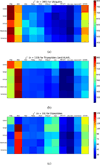Are Protein Force Fields Getting Better? A Systematic Benchmark on 524 Diverse NMR Measurements
- PMID: 22754404
- PMCID: PMC3383641
- DOI: 10.1021/ct2007814
Are Protein Force Fields Getting Better? A Systematic Benchmark on 524 Diverse NMR Measurements
Abstract
Recent hardware and software advances have enabled simulation studies of protein systems on biophysically-relevant timescales, often revealing the need for improved force fields. Although early force field development was limited by the lack of direct comparisons between simulation and experiment, recent work from several labs has demonstrated direct calculation of NMR observables from protein simulations. Here we quantitatively evaluate recent molecular dynamics force fields against a suite of 524 chemical shift and J coupling ((3)JH(N)H(α), (3)JH(N)C(β), (3)JH(α)C', (3)JH(N)C', and (3)JH(α)N) measurements on dipeptides, tripeptides, tetra-alanine, and ubiquitin. Of the force fields examined (ff96, ff99, ff03, ff03*, ff03w, ff99sb*, ff99sb-ildn, ff99sb-ildn-phi, ff99sb-ildn-nmr, CHARMM27, OPLS-AA), two force fields (ff99sb-ildn-phi, ff99sb-ildn-nmr) combining recent side chain and backbone torsion modifications achieve high accuracy in our benchmark. For the two optimal force fields, the calculation error is comparable to the uncertainty in the experimental comparison. This observation suggests that extracting additional force field improvements from NMR data may require increased accuracy in J coupling and chemical shift prediction. To further investigate the limitations of current force fields, we also consider conformational populations of dipeptides, which were recently estimated using vibrational spectroscopy.
Figures





Similar articles
-
Comparison of Secondary Structure Formation Using 10 Different Force Fields in Microsecond Molecular Dynamics Simulations.J Chem Theory Comput. 2012 Aug 14;8(8):2725-2740. doi: 10.1021/ct300323g. Epub 2012 Jun 19. J Chem Theory Comput. 2012. PMID: 22904695 Free PMC article.
-
Critical Assessment of Current Force Fields. Short Peptide Test Case.J Chem Theory Comput. 2013 Jan 8;9(1):441-51. doi: 10.1021/ct300794a. Epub 2012 Dec 14. J Chem Theory Comput. 2013. PMID: 26589046
-
Effects of force fields on the conformational and dynamic properties of amyloid β(1-40) dimer explored by replica exchange molecular dynamics simulations.Proteins. 2018 Mar;86(3):279-300. doi: 10.1002/prot.25439. Epub 2017 Dec 25. Proteins. 2018. PMID: 29235155
-
Biomolecular force fields: where have we been, where are we now, where do we need to go and how do we get there?J Comput Aided Mol Des. 2019 Feb;33(2):133-203. doi: 10.1007/s10822-018-0111-4. Epub 2018 Nov 30. J Comput Aided Mol Des. 2019. PMID: 30506158 Review.
-
Recent advances in macromolecular hydrodynamic modeling.Methods. 2011 May;54(1):101-14. doi: 10.1016/j.ymeth.2010.10.005. Epub 2010 Nov 10. Methods. 2011. PMID: 21073955 Free PMC article. Review.
Cited by
-
Synergy between NMR measurements and MD simulations of protein/RNA complexes: application to the RRMs, the most common RNA recognition motifs.Nucleic Acids Res. 2016 Jul 27;44(13):6452-70. doi: 10.1093/nar/gkw438. Epub 2016 May 18. Nucleic Acids Res. 2016. PMID: 27193998 Free PMC article.
-
Accurate Simulations of Lipid Monolayers Require a Water Model with Correct Surface Tension.J Chem Theory Comput. 2022 Mar 8;18(3):1862-1869. doi: 10.1021/acs.jctc.1c00951. Epub 2022 Feb 8. J Chem Theory Comput. 2022. PMID: 35133839 Free PMC article.
-
Residual Structures and Transient Long-Range Interactions of p53 Transactivation Domain: Assessment of Explicit Solvent Protein Force Fields.J Chem Theory Comput. 2019 Aug 13;15(8):4708-4720. doi: 10.1021/acs.jctc.9b00397. Epub 2019 Jul 10. J Chem Theory Comput. 2019. PMID: 31241933 Free PMC article.
-
Stability of transmembrane amyloid β-peptide and membrane integrity tested by molecular modeling of site-specific Aβ42 mutations.PLoS One. 2013 Nov 7;8(11):e78399. doi: 10.1371/journal.pone.0078399. eCollection 2013. PLoS One. 2013. PMID: 24244308 Free PMC article.
-
Binding and Flip as Initial Steps for BP-100 Antimicrobial Actions.Sci Rep. 2019 Jun 13;9(1):8622. doi: 10.1038/s41598-019-45075-5. Sci Rep. 2019. PMID: 31197199 Free PMC article.
References
Grants and funding
LinkOut - more resources
Full Text Sources
